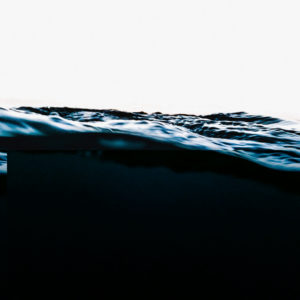There are many references to the history of art and to our personal experience evoked by Cédric Dasesson’s photographs. In the exhibition at The AB Factory gallery, a beautiful young space already with an interesting program, and in the accurate catalog the photos are divided into three levels that decline three different approaches, three looks on the sea where the visual data become almost epistemological: Level 1 Above sea, Level 2 Sea Level, Level 3 Under Sea, photographs above, at the surface-under the sea. Even the mode of writing LEVEL in the catalog refers to the symmetry of the three levels, in which the V is the axis between, and in which, the other two are reflected.
First of all, what sea is it? Lately we have seen many works in which the sea is transformed by man into a dramatic element: the sea poisoned by chemicals and plastics, recurring in the last Biennials, or a place of slave trade in many contemporary works. It is the actualization of a sea that has already seen tragedies in the history of art: from the endless naval battles of Claude Lorrain to The Raft of Medusa of Gericault. But the sea of Dasesson is not that dramatic. On the contrary, there is the hedonistic sea, that of bodies’s ostentation of the consumption of sun and sand. A recent sea, after World War II, immortalized by some hyper-realists artists. But not even this is the sea of Dasesson.
There is the sea as a mirror of human feeling. The stormy sea, the rough sea, the riot of the waves, the lapping, the flat sea, every movement and state of the sea becomes a metaphor of our feelings. This is the vein of Romanticism: Frederich’s man looking at the sea of fog looks deep inside himself, which Dasesson seems to quote in the opening photograph of the catalog and in other photos with figures seen from behind. Or Turner tied to the mast of the ship to face from inside and then paint the swirl of the storms, as Dasesson climbs on a cliff risking to be carried away by the waves. Or, coming back further, the harmony and perfection of the freshly rippled flat sea of Botticelli’s Birth of Venus remembered by Level One 10, with the woman standing behind the sky between sea and sky.
Dasesson’s sea seems to be another sea. A sea portrayed with the refined control of the frame, of the luminosity, of the digital color, but reinterpreting panoramas and close-ups with sensitivity and almost metaphorical effects, starting from the articulation of the three levels. Psychoanalytic metaphor: watching the sky in Level 1 Above sea as Super Ego, staying at sea level in Level 2 Sea Level as being in the Ego, exploring the depth of the sea in Level 3 Under Sea as you explore the Id. Or philosophical and epistemological metaphor, from the almost scientific detachment of the look from the top in Level 1 Above sea to the approach in Level 2 Sea Level.
Looking at the Sea Level the relationship that Dasesson has with the sea would seem philosophical, we can also say that Dasesson looks at the sea as the philosopher looks at reality, looks at the world, with a critical detachment on the one hand and the emotional participation on the other. The matter of the levels is just a discourse about the way we look at the world, or, if we want, at man. From inside. From the darkness of the sea depths we pass to the surface waves and up to the whiteness of the air. The analysis of a sketch of water that ends in a drop suspended in the air, a blinding sun, a blurred boat, seen from the water that grows up to hide part of the boat, a composition in which blue sea, brown rock and whiteness of the air divide the space in a Mondrian’s way according to the weight of the colors.
When Dasesson looks down on Above sea, he creates abstract compositions with strips of green vegetation, white sand, blue sea. In some cases it is the oblique cut that interprets abstraction, with strips of sand, foam, wave, and light on the sea in the distance. Or a diffused whiteness that fades into the blue that identifies itself as beach because of a micro-figurine placed on a lower corner of the composition. In short, as for abstract painters, it creates a discourse of balance, of nuances and color changes.
Under sea is the most suggestive level, the figures that move in the water like ghosts, like waving, flickering figures that pass into another space, the human figure here loses consistency, liquefies, penetrates headlong towards the depth of the seabed, a figure lies beneath the surface of the water as if to mark the boundary between the two worlds, of the clear water below, and the blurred cloud above. And, almost like a manifesto of all this, a hand extended towards its refraction to seek a contact between the two worlds.
In short, very simply, those who live in a seaside town have a special relationship with the sea that is not that of those who come from outside and see it for the first time. Obviously an artist who lives in a seaside place and sees it with the depth that is his own, with the ability to see what others do not see, is able to make us live something that we could not even imagine before.
We interviewed Andrea Concas, founder of Art Backers, who in collaboration with The AB Factory present the exhibition LEVEL by CÉDRIC DASESSON to let us explain how Art Backers was born.
AB: I come from years of work experience where I have always been involved in museum installations, exhibitions, cultural and editorial marketing for public and private Institutions. Since I was a child, I “went around” between art galleries, museums, collections and exhibitions, where I was lucky to have a contact with the works of great artists like Picasso, Renoir, Caillebotte. Very soon, moved by a great passion, I started collecting multiple art while I remember, with great emotion, the first work a multiple of Joan Mirò, with the artist’s signature in pencil at the bottom right of the screen printing.
The passion for the collection was for me the key to access in a world that immediately fascinated me, so much so that, in 2016, I decided to give new course to my working life and to found Art Backers, an innovative artisan start up , which operates in the art and culture sector, supporting artists and promoting the production of works and art multiples. The name of the start up, Art Backers, not by chance, means supporting art and supporting artists, in fact we help them in production, promotion, legal support, communication and marketing. Art Backer also acts as an art publisher, and in support of the activities of collectors, museums, bank collections and Public Institutions. A qualified point on which we are also operating, with a large group of professionals, concerns the protection of copyright, an ambitious international project.
In support of art and multiples, the first gallery in Cagliari, The AB Factory, was inaugurated, reflecting the idea of supporting artists by offering them a Creative Space hosting events, courses and workshops, and a Print House in which we invite selected artists to work and make limited edition multiples. Cagliari was the starting point that gave us a lot of satisfaction, exceeding the five thousand visits to the gallery, on this experience, in 2018, we will start the creation of a network of “The AB Gallery” Art Galleries in major Italian and European cities .
Our team works with emerging and established artists to offer, to collectors or simple art lovers, attention and quality in the selection of the works; after the enthusiastic opening group show of the “Multi Street Art” gallery, where we presented for the first time in Sardinia great international street artists including Banksy, other exhibitions and meetings were followed. Now the first photographic exhibition in Italy by Cédric Dasesson is underway, entitled: Level.
We started collaborating with Cédric last year with his first Art Edition limited edition work and subsequently “naturally” established itself in our exhibition programs. Cédric Dasesson elaborates the images of his works in the theme of the seascape that we see on the walls of the gallery reworked on three cognitive levels: underwater, on the surface and on the top. Choosing to produce his first exhibition in Italy was not a particularly difficult decision thanks to the quality of his work and the absolute compositional rigor that makes him a refined young interpreter of “collective imagination”. The exhibition will be held in Cagliari as scheduled until 31 January 2018, but, seen the large turnout, it is possible that we will decide to extend it, and then start a tour for other prestigious European locations.
 Cédric Dasesson, LEVEL Above Sea, 2017
Cédric Dasesson, LEVEL Above Sea, 2017
 Cédric Dasesson, LEVEL Sea Level, 2017
Cédric Dasesson, LEVEL Sea Level, 2017
 Cédric Dasesson, LEVEL Sea Level, 2017
Cédric Dasesson, LEVEL Sea Level, 2017
 Cédric Dasesson, LEVEL Under Sea, 2017
Cédric Dasesson, LEVEL Under Sea, 2017

Emanuele Magri teaches History of Art in Milan. Since 2007 he has been writing abroad for Juliet art Magazine. Since the 1970s he has dealt with writing and visual arts. He created taxonomically defined worlds, in which he experimented with the self-referentiality of language, such as “La Setta delle S’arte” in which ritual clothes are made starting from words with multiple meanings, the “Treaty of genetic art” in which a series of plants is obtained from grafts of human organs, eyes, hands, mouths, etc., and the project “Fandonia”, a city where everything is double and hybrid.







NO COMMENT